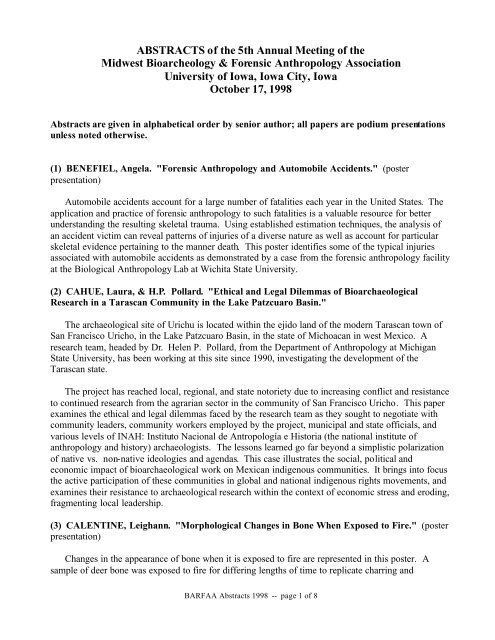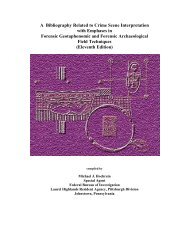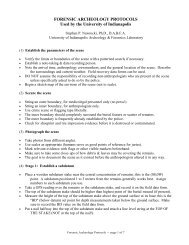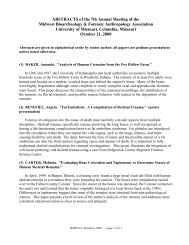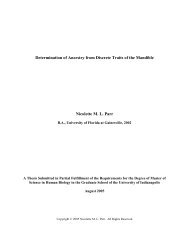ABSTRACTS of the 5th Annual Meeting of the Midwest ...
ABSTRACTS of the 5th Annual Meeting of the Midwest ...
ABSTRACTS of the 5th Annual Meeting of the Midwest ...
Create successful ePaper yourself
Turn your PDF publications into a flip-book with our unique Google optimized e-Paper software.
adiological observations, comparisons <strong>of</strong> injuries resulting from direct abuse and accidents, and signs<strong>of</strong> ongoing abuse.(11) INDRIATI, Etty. "A Dental Anthropological Approach to Coca-leaf Chewing in <strong>the</strong>Andes." (poster presentation)The effects <strong>of</strong> coca-leaf chewing on teeth in <strong>the</strong> Prehispanic Andes have been associated withvarious lesions such as massive calculus formation, green calcareous accretion, antemortem posteriortooth loss, root caries, and irregular alveolar resorption. These suppositions are, however, not based onclinical evidence from contemporary coca-leaf chewers. This results in <strong>the</strong> absence <strong>of</strong> knowledge on<strong>the</strong> distribution <strong>of</strong> coca-leaf chewers in <strong>the</strong> Prehispanic Andes, although <strong>the</strong> practice has been evidentfor five thousand years. I have developed a method for predicting <strong>the</strong> occurrence <strong>of</strong> coca-leaf chewingfor Prehispanic Andean remains, based on oral health surveys <strong>of</strong> contemporary Andean coca-leafchewers and non-chewers. Logistic regression analysis was used to yield a formula to predict <strong>the</strong>likelihood that any individual is a coca-leaf chewer. The Logistic Model is <strong>the</strong>n applied to prehispanicskeletal remains from highland Tiwanaku Bolivia, <strong>the</strong> sou<strong>the</strong>rn coast <strong>of</strong> Peru, and <strong>the</strong> nor<strong>the</strong>rn coast <strong>of</strong>Chile, dating from 2500 BC to AD 1600. The results <strong>of</strong> this work are important not onlymethodologically but also for revealing <strong>the</strong> distribution <strong>of</strong> coca-leaf chewers across populations indifferent geographical regions and through time in <strong>the</strong> Andes. This in turn demonstrates that dental orbiological phenomena, toge<strong>the</strong>r with archaeological evidence, can provide indelible clues to unravelpast cultures, when written records are not available.(12) JARSKI, Allison, & Peer MOORE-JANSEN. "Cranial Thickness and <strong>the</strong> Effect <strong>of</strong> Age."The present paper addresses <strong>the</strong> potential effect <strong>of</strong> age on cranial thickness in a sample <strong>of</strong> AfricanAmerican crania from <strong>the</strong> U.S. <strong>Midwest</strong>. Potential differences between male and female are alsoreviewed. Previous research explored cranial thickness as a means <strong>of</strong> determining sex and agedifferences in a Caucasoid sample from <strong>the</strong> U.S. Sou<strong>the</strong>ast, concluding that females exhibit a steadyincrease in cranial thickness with age. The increase is noted in <strong>the</strong> frontal region in particular and,although it is described as steady, it is followed by an abrupt increase in thickness around age 65. Inturn, males exhibit a steady decrease in thickness with age. The results reported are in contrast to o<strong>the</strong>rstudies <strong>of</strong> cranial thickness which indicate that measurements increase with age in both males andfemales.For <strong>the</strong> present study, a sample was drawn from <strong>the</strong> R.J. Terry Collection. Each cranium wasmeasured at 19 landmarks/areas <strong>of</strong> <strong>the</strong> vault using spreading calipers. At present, preliminary findingsreveal a general trend towards an increase in cranial thickness in females and males, although to alesser extent in <strong>the</strong> male crania. The difference between <strong>the</strong> results presented here and previousfindings is suggested to reflect a potential group-specific effect. Sexually dimorphic features are alsonoted in <strong>the</strong> cranium but vary among landmark and locations.(13) JOHNSTON, Cheryl, Mat<strong>the</strong>w WILLIAMSON, & Steven SYMES. "The Fort LaurensSkeletal Sample: Cranial Trauma."Fort Laurens, located near <strong>the</strong> present day town <strong>of</strong> Bolivar, Ohio, was established in 1778 under<strong>the</strong> command <strong>of</strong> General Lachlan McIntosh. During <strong>the</strong> nine months <strong>of</strong> <strong>the</strong> fort's occupation, at least21 individuals were buried in <strong>the</strong> fort's cemetery. Instances <strong>of</strong> cranial traumata were identified anddescribed for 19 <strong>of</strong> <strong>the</strong>se individuals. Type, location, and dimensions <strong>of</strong> each trauma were recorded.BARFAA Abstracts 1998 -- page 4 <strong>of</strong> 8
Results indicate an average <strong>of</strong> 3.8 instances <strong>of</strong> cranial traumata per individual. All individuals exhibitat least one instance <strong>of</strong> cranial trauma, and <strong>the</strong> maximum number exhibited by any one individual iseight. Types <strong>of</strong> trauma observed include blunt force and at least two distinct types <strong>of</strong> sharp trauma.Radiography failed to provide confirmation <strong>of</strong> gunshot trauma although perimortem damage consistentwith gunshot trauma was observed.(14) KIMMERLE, Erin, Matthias OKOYE, & Karl REINHARD. "Deaths in Custody inNebraska, USA: A Statistical Analysis and Report <strong>of</strong> Unusual Cases."All medicolegal cases from <strong>the</strong> Lancaster County Coroner's Office in Lincoln, Nebraska, USA,1991 through 1996, were reviewed for deaths which occurred in custody. The leading manners <strong>of</strong>death, in ranked order, include: natural 45.1% (23/51), suicide 33.3% (17/51), homicide 11.8% (6/51),accident 7.8% (4/51), and undetermined 2% (1/51). Each manner <strong>of</strong> death is explored considering <strong>the</strong>following variables: cause <strong>of</strong> death, age, sex, and race <strong>of</strong> <strong>the</strong> decedents. The findings <strong>of</strong> thisinvestigation are compared with previous studies in o<strong>the</strong>r geographic regions <strong>of</strong> <strong>the</strong> country. Manysimilarities and differences in <strong>the</strong> frequencies <strong>of</strong> <strong>the</strong> modes <strong>of</strong> death are discussed. In addition, sixunusual case studies are presented and may serve as a reference for pathologists and o<strong>the</strong>r forensicscientists confronted with aberrant cases, including one accidental death, one homicide, and foursuicides.(15) KISSACK, Zachary. "Surgically Implanted Skeletal Appliances and Their ForensicApplications." (poster presentation)I address <strong>the</strong> topic <strong>of</strong> surgically implanted skeletal appliances in <strong>the</strong> skeletons <strong>of</strong> living humans and<strong>the</strong> potential role that such appliances can assume in forensic identification. Various artificialappliances implanted during surgical reconstruction and/or repair, particularly in cases dealing with <strong>the</strong>shoulder, are discussed. Pictures/diagrams will show a typical shoulder joint as compared to one thathas been repaired through <strong>the</strong> use <strong>of</strong> surgically implanted staples. The potential use <strong>of</strong> surgicalappliances in forensic identification arises from <strong>the</strong> fact that appliances implanted into <strong>the</strong> humanskeleton are cataloged according to type and manufacturer as well as by individual serial number.(16) MYERS, Jeri. "Skeletal Analysis <strong>of</strong> an Athlete."The discovery and early confirmed identification <strong>of</strong> skeletal remains found in western Nebraskaprovided forensic anthropologists an opportunity to evaluate skeletal pathology and anomalies in <strong>the</strong>context <strong>of</strong> a known lifestyle. The extensive athletic training and documented injuries <strong>of</strong> <strong>the</strong> individualunder discussion correspond with bone remodeling resulting from trauma, pronounced osteologicaldevelopment at sites <strong>of</strong> muscle attachment, evidence <strong>of</strong> osteolytic activity, and arthritis. Sidepreference associated with particular repeated motions required in sports in which <strong>the</strong> individual wasknown to have participated may explain <strong>the</strong> observed asymmetry <strong>of</strong> some skeletal elements.(17) NAWROCKI, Stephen. "An Overview <strong>of</strong> Human Taphonomy."Human taphonomy is a subfield <strong>of</strong> anthropology that examines <strong>the</strong> role <strong>of</strong> peri- and postmortemprocesses on human bone and s<strong>of</strong>t tissues. The central concerns <strong>of</strong> human taphonomy include: (1)distinguishing between "pseudotrauma" and damage actually inflicted at <strong>the</strong> time <strong>of</strong> death, (2)explaining <strong>the</strong> postmortem history <strong>of</strong> a skeleton and applying this information in archeological anddemographic contexts, and (3) estimating <strong>the</strong> postmortem interval for <strong>the</strong> more recently deceased.BARFAA Abstracts 1998 -- page 5 <strong>of</strong> 8
e aware that permission to conduct <strong>the</strong> research must still be obtained. However, because <strong>the</strong>infrastructure <strong>of</strong> <strong>the</strong> country may be greatly disrupted, it may be exceedingly difficult to discover all <strong>of</strong><strong>the</strong> proper individuals, agencies, and/or authorities which actually have <strong>the</strong> authority or responsibilityto grant that permission. In addition, families <strong>of</strong> <strong>the</strong> missing as well as religious leaders <strong>of</strong> <strong>the</strong>community may have to be consulted. Research that will potentially aid <strong>the</strong> identification process isprobably most appropriate and acceptable under <strong>the</strong>se conditions. Research that actively incorporateslocal colleagues is also appropriate.In no circumstance should one assume that <strong>the</strong> skeletal remains are readily available for study. Inno circumstance should an employee <strong>of</strong> an organization conducting this type <strong>of</strong> work assume that datacollection is allowed; <strong>the</strong> employee has been hired to perform certain tasks, not to collect data forpersonal projects.(21) WOLFE STEADMAN, Dawnie. "Preliminary Analysis <strong>of</strong> <strong>the</strong> Pawn Shop Mummy."A mummified human skull was confiscated from a pawn shop by <strong>the</strong> Des Moines PoliceDepartment in June, 1998. The s<strong>of</strong>t tissue <strong>of</strong> <strong>the</strong> face and submandibular region are extremely wellpreserved, as is a full mustache. The vault was quarter-sectioned and, while <strong>the</strong> brain was removed,<strong>the</strong> dura mater remained in situ. At <strong>the</strong> time <strong>of</strong> discovery, <strong>the</strong> authorities were concerned that <strong>the</strong> skullwas from an American Indian cemetery or that <strong>of</strong> a recent missing person. However, anthropologicalanalysis determined that <strong>the</strong> skull was <strong>of</strong> a Caucasian adult male, approximately 4050 years <strong>of</strong> age.The manner <strong>of</strong> death could not be determined. The type <strong>of</strong> autopsy, purposeful exposure <strong>of</strong> <strong>the</strong> rightmastoid region and chemical preservation <strong>of</strong> <strong>the</strong> s<strong>of</strong>t tissue are consistent with a historical anatomicalpreparation used for teaching purposes. Two modes <strong>of</strong> investigation are currently being pursued todetermine <strong>the</strong> antiquity <strong>of</strong> <strong>the</strong> preparation: <strong>the</strong> types <strong>of</strong> preservatives and autopsy tools utilized. Theresults <strong>of</strong> <strong>the</strong>se investigations and analyses will be presented and <strong>the</strong> importance <strong>of</strong> interdisciplinarycollaboration will be emphasized.(22) WESCOTT, Daniel. "Variation in Asymmetry <strong>of</strong> <strong>the</strong> Humerus Within <strong>the</strong> Arikara: APreliminary Look."Because <strong>the</strong> gross architecture <strong>of</strong> a bone is, at least in part, a reflection <strong>of</strong> <strong>the</strong> physical loads placedon it, examination <strong>of</strong> bone size and shape can <strong>of</strong>ten provide significant clues regarding habitualphysical activities. An examination <strong>of</strong> bilateral asymmetry in <strong>the</strong> architecture <strong>of</strong> limb bones can evenfur<strong>the</strong>r assist in teasing out patterns associated with habitual physical activities. Activities requiringequal use <strong>of</strong> <strong>the</strong> right and left limbs result in a relatively small degree <strong>of</strong> bilateral asymmetry.Activities requiring a greater use <strong>of</strong> one limb over <strong>the</strong> o<strong>the</strong>r, on <strong>the</strong> o<strong>the</strong>r hand, will induce anincreased bone density and mass in <strong>the</strong> dominant limb bone. The outcome <strong>of</strong> this increased bone massin <strong>the</strong> dominant limb is a more pronounced bilateral asymmetry <strong>of</strong> <strong>the</strong> limb bones. This paper presentsand discusses preliminary results <strong>of</strong> an investigation into <strong>the</strong> bilateral asymmetry exhibited in <strong>the</strong>external dimensions <strong>of</strong> humeri from precontact and postcontact Arikara. The preliminary resultsindicate a possible temporal change in humeral bilateral asymmetry.BARFAA Abstracts 1998 -- page 7 <strong>of</strong> 8
Copyright © 1998 by <strong>the</strong> Individual AuthorsThe authors grant permission for this document to be copied and distributed for personal andeducational use as long as proper citation is given. Commercial use <strong>of</strong> this document is forbiddenwithout <strong>the</strong> prior consent <strong>of</strong> <strong>the</strong> authors.Suggested citation <strong>of</strong> individual abstracts (example): Benefiel A (1998). Forensic anthropologyand automobile accidents (abstract). Presented at <strong>the</strong> <strong>5th</strong> <strong>Annual</strong> <strong>Meeting</strong> <strong>of</strong> <strong>the</strong> <strong>Midwest</strong>Bioarcheology & Forensic Anthropology Association, Iowa City IA. University <strong>of</strong> IndianapolisArcheology & Forensics Laboratory (http://archlab.uindy.edu).Last update 6-30-06BARFAA Abstracts 1998 -- page 8 <strong>of</strong> 8


